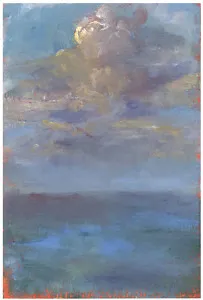 This Fall Immerse yourself in the Umbrian countryside with the bountiful harvest of olives and wine while painting and exploring artistic treasures with Jill. The all-inclusive experience, features: Saturday and Sunday Brunch with Prosecco; painting on Saturday with instruction from Jill, dinner off the grill on the terrace with regional wine Saturday Night, Sunday Morning Art Conversation, Tour of Assisi after Sunday Brunch, Transfer to Fiumicino airport (FCO) after breakfast Monday.
This Fall Immerse yourself in the Umbrian countryside with the bountiful harvest of olives and wine while painting and exploring artistic treasures with Jill. The all-inclusive experience, features: Saturday and Sunday Brunch with Prosecco; painting on Saturday with instruction from Jill, dinner off the grill on the terrace with regional wine Saturday Night, Sunday Morning Art Conversation, Tour of Assisi after Sunday Brunch, Transfer to Fiumicino airport (FCO) after breakfast Monday.
Participants will be housed in the remarkably well-preserved Umbrian hill town of Monte Castello di Vibio. Again, your workshop package is all-inclusive and worry-free, providing departure services and airport transfer to the Rome Fiumicino, Leonardo Da Vinci Airport (FCO). Aboard our comfortable private bus, single occupancy accommodations with shared bath (a wide range of upgrades with private bath are available), lunch and dinner on Friday, Prosecco brunch and grilled dinner on Saturday and Sunday. Your workshop includes one excursion per week and many additional options are available on weekends for an additional fee. Of course, 24/7 access to facilities and 24/7 bi-lingual support are provided.
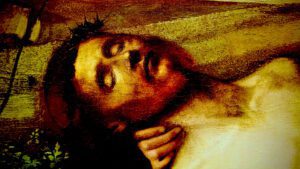 In the 14th c. Sicilian painter, Antonello di Messina brought the new medium of oil painting to Italy. In his travels, he brought the medium to Venice, where artists such as Giovanni Bellini, adopted, and expanded the expressive potential of the medium. Perhaps one of the most influential painting teachers in history, Bellini’s pupils included some of the greatest figures in the history of the medium: Titian, Tintoretto, and Veronese. Their often huge, operatic paintings mark a kind of crowning achievement for the medium, and the processes they developed consequently influenced other great artists and schools of art that included Caravaggio, Rembrandt, Velazquez and countless others who have followed in their path.
In the 14th c. Sicilian painter, Antonello di Messina brought the new medium of oil painting to Italy. In his travels, he brought the medium to Venice, where artists such as Giovanni Bellini, adopted, and expanded the expressive potential of the medium. Perhaps one of the most influential painting teachers in history, Bellini’s pupils included some of the greatest figures in the history of the medium: Titian, Tintoretto, and Veronese. Their often huge, operatic paintings mark a kind of crowning achievement for the medium, and the processes they developed consequently influenced other great artists and schools of art that included Caravaggio, Rembrandt, Velazquez and countless others who have followed in their path.
This workshop will follow the oil painting methods of the great Venetian masters. Working from reproductions, participants will reproduce easel-sized works of the Venetian school of the 16th-18th c. They may also choose to copy a detail from larger Venetian masterworks. To as great an extent possible, students will use the same materials of 15th and 16th c. Venetian artists, many of which will be prepared by hand in class, according to traditional recipes.
Beginning on a uniquely coarse, stretched canvas (approximately 36” x 30”) prepared with rabbit skin glue and white lead, participants will apply a colored ground. This rich, colored surface establishes an overall, atmospheric tonality, that also functions as a very useful neutral color. This then, serves as the basis for the serendipitous approach to color and the remarkable atmospheric effects that are unique to this school of painting.
On this rich surface, participants will transfer perforated drawings with charcoal and a pounce as was done in this time. Afterward, earth colors, carbon black, and white lead ground in oil will be prepared by the class. With these basic colors, an underpainting will be developed using alternating layers of washes and thick impasto areas of white lead. Afterward, rich layers of transparent colors made primarily from pigments produced in in our Pigments and Paint Workshop will be applied. In the process, students will develop an unders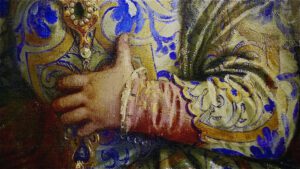 tanding of the important terms, glaze (a dark, thinned color over a lighter surface) and scumble (a thin layer of white lead) as they seek to reproduce the sumptuous color and dramatic brushwork characteristic of the Venetian School.
tanding of the important terms, glaze (a dark, thinned color over a lighter surface) and scumble (a thin layer of white lead) as they seek to reproduce the sumptuous color and dramatic brushwork characteristic of the Venetian School.
During the class participants will have the unique opportunity to see remarkable examples of work by the Venetian masters in person during our excursion to the Pitti Palace in Florence.
Throughout the workshop, participants will be housed in the remarkably well-preserved Umbrian hill town of Monte Castello di Vibio. Your workshop package is all-inclusive, providing welcome and departure services and airport transfer from the Rome Fiumicino, Leonardo Da Vinci Airport (FCO). Aboard our comfortable private bus, single occupancy accommodations with shared bath (a wide range of upgrades with private bath are available), 3 meals per day Monday-Thursday, Prosecco brunch and dinner on Saturday and Sunday (no meals are served on Friday, our excursion day. Your workshop includes an excursion to Florence. Of course, throughout your stay, 24/7 access to facilities and 24/7 bi-lingual support are provided.
Price of the workshop includes all materials needed to produce the painting described above, except brushes, which will be available for sale at ICA in Italy. While it is unlikely that the painting will be completed in the timeframe allowed by the workshop, our goal is to give participants a sufficient understanding of the Venetian process in order to complete the painting at home. As part of the course fee, participants will be issued a unique folding stretcher that allows the painting itself to be folded into a carry-on luggage-sized parcel, even if not fully dry.
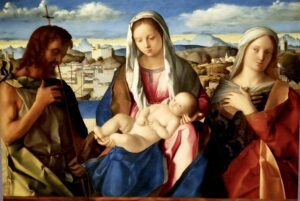 Oil painting developed in Northern Europe early in the 15th c. and Italian painters of the next generation quickly adopted the medium to their own unique vocabulary. Antonello di Messina is generally credited with the introduction of oil painting to Italy and more specifically, to Venice. Artists such as Giovanni Bellini, as well as Leonardo further expanded the expressive potential of the medium. The processes that these artists developed consequently influenced the whole history of Western Art.
Oil painting developed in Northern Europe early in the 15th c. and Italian painters of the next generation quickly adopted the medium to their own unique vocabulary. Antonello di Messina is generally credited with the introduction of oil painting to Italy and more specifically, to Venice. Artists such as Giovanni Bellini, as well as Leonardo further expanded the expressive potential of the medium. The processes that these artists developed consequently influenced the whole history of Western Art.
This workshop will follow their methods. Working from reproductions participants will use materials of the time, prepared by hand in a traditional way. Beginning on a wooden panel, prepared with rabbit skin glue and chalk gesso, participants will transfer their perforated drawings with charcoal and a pounce, then develop a wash drawing with genuine sepia ink, followed by an imprimatura – a colored “veil” - that establishes a tonality and a very useful neutral color. From here, oil paint ground in class will be used to develop the underpainting. Afterwards, rich glazes of transparent colors made primarily from pigments produced in in our Pigments and Paint Workshop.
Throughout the workshop, participants will be housed in the remarkably well-preserved Umbrian hill town of Monte Castello di Vibio. Your workshop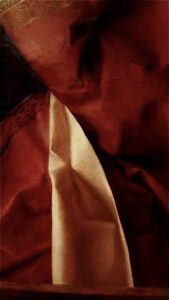
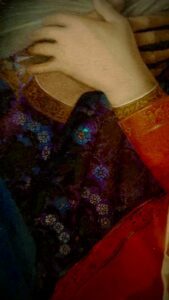
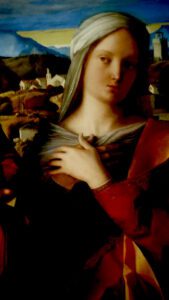 package is all-inclusive, providing welcome and departure services and airport transfer from the Rome Fiumicino,Leonardo Da Vinci Airport (FCO). Aboard our comfortable private bus, single occupancy accommodations with shared bath (a wide range of upgrades with private bath are available), 3 meals per day Monday-Thursday, Prosecco brunch and dinner on Saturday and Sunday (no meals are served on Friday, our excursion day. Your workshop includes an excursion to Perugia. Of course, throughout your stay, 24/7 access to facilities and 24/7 bi-lingual support are provided.
package is all-inclusive, providing welcome and departure services and airport transfer from the Rome Fiumicino,Leonardo Da Vinci Airport (FCO). Aboard our comfortable private bus, single occupancy accommodations with shared bath (a wide range of upgrades with private bath are available), 3 meals per day Monday-Thursday, Prosecco brunch and dinner on Saturday and Sunday (no meals are served on Friday, our excursion day. Your workshop includes an excursion to Perugia. Of course, throughout your stay, 24/7 access to facilities and 24/7 bi-lingual support are provided.
Price of the workshop includes all materials needed to produce the painting described above, except brushes, which will be available for sale at ICA in Italy. While it is unlikely that the painting will be completed in the timeframe allowed by the workshop, our goal is to give participants a sufficient understanding of the Northern Renaissance process in order to complete the painting at home. As part of the course fee, participants will be issued a unique case for the painting that allows the painting itself to be folded into a carry-on luggage-sized parcel even if not fully dry.
 A hands-on workshop on producing painting and drawing materials according to historical methods. The intensive, week-long workshop is ideal for painters interested in gaining greater familiarity with their materials, academics and teachers interested in curricular development, art historians, and people interested in developing a deeper understanding of traditional works.
A hands-on workshop on producing painting and drawing materials according to historical methods. The intensive, week-long workshop is ideal for painters interested in gaining greater familiarity with their materials, academics and teachers interested in curricular development, art historians, and people interested in developing a deeper understanding of traditional works.
Born in 1360, painter Cennino d’Andrea Cennini, left a remarkable legacy, beyond that of his surviving works.
A student, of a student, of Giotto, Cennino left of us a remarkable and intimate record of the life and working processes of a painter in his time. His book is called, il Libro del’Arte, simply, “The Book of Art.” It provides insights into the training of the artists of his time, as well as that of the next generations of artists in Italy. Incredibly, this included some of the greatest figures in the history of Western painting: Masaccio, Fra Angelico, Leonardo, Botticelli, Michelangelo, and Raphael among others. To the reader of today, Cennini’s text provides the remarkable opportunity to participate in this legacy.
On a practical level, Cennini’s book is also a very useful guide to the production of pigments, paints, painting surfaces, and other materials of the medieval and Renaissance artist. In this however, it also reveals something larger than that of a recipe book. It speaks to a very special connection between artists and the materials they choose. Often, that connection resulted from artists making their materials themselves, by hand. Indeed, Cennini refers lovingly to the rare, almost spiritual beauty of, ultramarine blue to the easy, sensual qualities of a charcoal black as well as to their sometimes, tempestuous personalities of materials like, dragon’s blood!
What is revealed is a unique connection to the materials of the artist, in which all elements have significance. As translator, Daniel Thompson describes, “A very choice black was, and still is, made from peach stones; and almond shells were sometimes charred to produce another sort. To the outsider all these blacks would seem very much alike; indeed, they would probably be quite indistinguishable. But a painter of the medieval kind becomes familiar with the little quirks of personality in his pigments, and is affected by small subtleties which it is hopeless to try to define, subtleties not so much of color as of working quality, how the pigment feels, how it mixes, whether it tends to settle out of a color mixture, or stays nicely in suspension, and little things like that.” These “little things” can indeed have big effect to the artist who remains sensitive to the qualities of their materials, creating a bond that becomes a language of its own.
We will use Cennini’s book as a basis for our exploration of making pigments and paints. Guided by the experience of our staff, in collaboration with our long-time supplier, Kremer Pigmente, and the advantage of modern chemistry and production methods, we will embark on a historical overview of pigments used by artists throughout the ages - actually, making many pigments from raw ingredients. We will observe sometimes miraculous transformations in color, creating beautiful and luscious pigments that will last …forever. We will then turn these colored particles into a variety of paints, pastels, and charcoal. Our goal will be to produce the following materials which participants will take home with them at the end of the workshop:
20 g. Jars of pigment as follows:
3 ml. Jars of pigment as follows:
Inks as follow:
50 ml tubes of oil colors as follows:
20 ml jar of
Watercolors in natural mussel shell, as follows:
Pastels as follow:
In doing so, we will understand the processes of levigation, grading for optimal particle size, grinding, precipitation of lake colors, and many other processes. We will also make surfaces to be used in a variety of aqueous, solvent-based, and dry applications. At the end of the workshop, an excursion to the National Gallery of Umbria in Perugia, will provide real examples from Cennini’s time and later, which will illustrate both the beauty and the permanence of these materials.
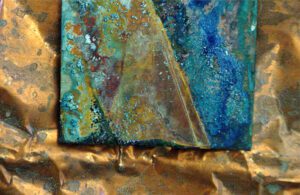 Participants will be housed in the remarkably well-preserved Umbrian hill town of Monte Castello di Vibio. Your workshop package is all-inclusive, providing welcome and departure services and airport transfer from the Rome Fiumicino, Leonardo Da Vinci Airport (FCO). Aboard our comfortable private bus, single occupancy accommodations with shared bath (a wide range of upgrades with private bath are available), 3 meals per day Monday-Thursday, Prosecco brunch and dinner on Saturday and Sunday (no meals are served on Friday, our excursion day. Your workshop includes one excursion per week and many additional options are available on weekends for an additional fee. Of course, 24/7 access to facilities and 24/7 bi-lingual support are provided.
Participants will be housed in the remarkably well-preserved Umbrian hill town of Monte Castello di Vibio. Your workshop package is all-inclusive, providing welcome and departure services and airport transfer from the Rome Fiumicino, Leonardo Da Vinci Airport (FCO). Aboard our comfortable private bus, single occupancy accommodations with shared bath (a wide range of upgrades with private bath are available), 3 meals per day Monday-Thursday, Prosecco brunch and dinner on Saturday and Sunday (no meals are served on Friday, our excursion day. Your workshop includes one excursion per week and many additional options are available on weekends for an additional fee. Of course, 24/7 access to facilities and 24/7 bi-lingual support are provided.
All materials for the class and the excursion are included in the cost of the workshop.
The study of human anatomy in Italy is a long and distinguished tradition. The extraordinary anatomical theatres in medical schools at the University of Padua and the University of Bologna bear witness to this history and were among the first of their kind in existence. Even today, we marvel at the accuracy and lifelike intensity of the 17 th c. wax anatomical models in the Specola Museum in Florence, which were made to allow medical students to observe venous, muscular, and skeletal systems without a cadaver. In this regard, the study of anatomy in Italy has profoundly impacted not only our understanding of the human body, but also the study of medicine in the western world.
Surprisingly, this history also reveals much about the significance of the role of visual art in furthering science and medicine. In his brilliant series of lectures at the Art Students League in New York, artist, anatomist, and scholar, Robert Beverly Hale once said: “science had actually sprung from art, that it had developed in those great periods when artists had looked at nature very closely and carefully, and had tried to record exactly what they saw. That, what we explained, was what scientists have been doing ever since.”
To support Hale’s observation one need look no further than Leonardo’s anatomical studies. These drawings are incredible not only for their accuracy and beauty as works of art, but also as a highly accurate analysis of function, of what anatomist George Bridgeman referred to as “the human machine.” Leonardo is perhaps unequalled in his analysis of the form of the human body as a manifestation of the interrelationship of functioning systems. It is known, for example that Leonardo once injected the heart of an ox with hot wax, then made a glass model of the casting. He then pumped the model with water to analyze the circulation of fluids in the human heart. Incredibly, Leonardo’s conclusions were not fully corroborated by cardiologists until the 1980’s.
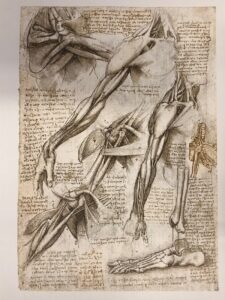 The objective of our Human Anatomy intensive is to follow in this tradition. Thus, we will not only identify anatomical structures of the human body, but we will also analyze the function of those structures and their effect on its outward form. Throughout the workshop, we will reference functional systems in understanding their manifestation in surface anatomy of the figure.
The objective of our Human Anatomy intensive is to follow in this tradition. Thus, we will not only identify anatomical structures of the human body, but we will also analyze the function of those structures and their effect on its outward form. Throughout the workshop, we will reference functional systems in understanding their manifestation in surface anatomy of the figure.
Our focus will be on the skeletal and muscular systems, with some analysis of the major arteries of the venous system. We will work from a variety of sources, including real human skeletons as well as drawing from our collection of anatomical models and plaster casts. Our medium in the course will be various drawing media in large-format sketchbooks as a means of note taking for the course.
Our approach will be in the form of lectures and hands on drawing focusing first on the skeletal system. We will draw from real human skeletons as well as anatomical models. We will explore one area of the body at a time, first in analyzing the skeletal structure of the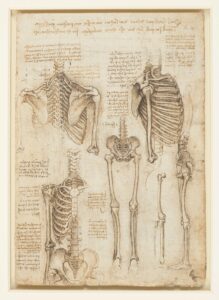 torso. Afterward, we will move on to the head, arms, and legs, as well as hands, and feet. Participants will produce life-sized drawings with charcoal on heavy paper as well as drawings in sketchbooks of details such as joint articulations.
torso. Afterward, we will move on to the head, arms, and legs, as well as hands, and feet. Participants will produce life-sized drawings with charcoal on heavy paper as well as drawings in sketchbooks of details such as joint articulations.
Afterward, the course will focus on the muscular system first through lecture and note-taking then by drawing from anatomical models, plaster casts, and the live model, in the same order. However, we will in exploring the muscular system we will utilize tracing paper and colored pencil, in order to add layers of muscles over our previous skeletal drawings.
In addition to the intensive schedule of daily drawing and lecture, we will make an excursion to the famed Specola Museum in Florence where we will draw from their collection of 16 th to 18th c. wax anatomical sculptures. The incredibly lifelike flayed figures are shockingly lifelike - at once factual and at the same time, powerfully expressive. Here, the wax models will provide an overview of the skeletal and muscular systems as well as an introduction to the venous system.
Throughout the workshop, participants will be housed in the remarkably well-preserved Umbrian hill town of Monte Castello di Vibio. Your workshop package is all-inclusive, providing welcome and departure services and airport transfer from the Rome Fiumicino, Leonardo Da Vinci Airport (FCO). Aboard our comfortable private bus, single occupancy accommodations with shared bath (a wide range of upgrades with private bath are available), 3 meals per day Monday-Thursday, Prosecco brunch and dinner on Saturday and Sunday (no meals are served on Friday, our excursion day. Your workshop includes one excursion per week and many additional options are available on weekends for an additional fee. Of course, 24/7 access to facilities and 24/7 bi-lingual support are provided.
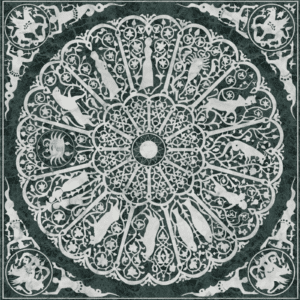 Imagine a week in which you are able to totally absorb yourself in workshop activities, away from the stresses of your daily lives and the pressures of the modern world. Consider an opportunity to dive into yourself and become present, focusing on expression and creativity. There is perhaps no place better for this than our little mountain village overlooking the Tiber Valley in the region of Umbria – known to Italians as “the green heart of Italy.” Here you will explore the body and mind through Yoga, painting, and drawing in a series of experimental workshops.
Imagine a week in which you are able to totally absorb yourself in workshop activities, away from the stresses of your daily lives and the pressures of the modern world. Consider an opportunity to dive into yourself and become present, focusing on expression and creativity. There is perhaps no place better for this than our little mountain village overlooking the Tiber Valley in the region of Umbria – known to Italians as “the green heart of Italy.” Here you will explore the body and mind through Yoga, painting, and drawing in a series of experimental workshops.
Basic Hatha yoga practice will allow participants to slow down, tune into oneself and ones breathing and let the body guide you through simple movements such as Surya Namaskar. Through meditation we will seek to find thoughtless awareness. Through drawing exercises such as mindful observation, we will use our senses to raise awareness and explore imagination through taste, touch and sound.
Students will aim to create a harmonious balance from a mix of structure and improvisation working on heavy grade watercolor paper. Using ink and watercolor, students will create non- objective drawings and paintings. We will be using a variety of techniques gained from studies in both European and Indian processes. We will grind pigments in binders, creating luscious water- based paints of exceptional richness and depth of color. We will prepare paper, underpaint with grids filled with basic algorithms of color over painted and layered with shapes and forms which are sanded, burnished, washed, reworked and detailed to give a final result. The objective is a wholistic approach that considers all elements as meaningful.
As an integral capstone to the experience, we will visit the beautiful city of Florence, where we will research historic designs found in art and architecture. In this, we will take a somewhat different perspective from that of art historical tours. Guided by Emma's background in anthropology we will explore new opportunities provided our own creative work. We will seek to expand our awareness of the mysterious world that the ageless city presents, as well as opportunities that typically unobserved objects and landscapes present.
Participants will be housed in the remarkably well-preserved Umbrian hill town of Monte Castello di Vibio. Your workshop package is all-inclusive, providing welcome and departure services and airport transfer from the Rome Fiumicino, Leonardo Da Vinci Airport (FCO). Aboard our comfortable private bus, single occupancy accommodations with shared bath (a wide range of upgrades with private bath are available), 3 meals per day Monday-Thursday, Prosecco brunch and dinner on Saturday and Sunday (no meals are served on Friday, our excursion day. Your workshop includes one excursion per week and many additional options are available on weekends for an additional fee. Of course, 24/7 access to facilities and 24/7 bi-lingual support are provided.
Menrva, the Etruscan goddess of creativity, was also known as the ‘Goddess of a Thousand Works” – an aspirational goal for writers and academics if there ever was one. There is no better place, then, to channel the spirit of Menrva and focus on your writing than in Umbria, the heart of Etruria, the land of the Etruscans, and the Green Heart of Italy!
The Second Annual Menrva Writing Retreat at the International Center for the Arts in Monte Castello di Vibio provides a week of glorious time and space to write, while also enjoying the beauty of Umbria, the hospitality of an Italian hill town, great conversation, and delicious food and wine!
Open to writers of all kinds, the Menrva retreat will offer the opportunity to engage with yourwork in a supportive community of writers and artists in a beautiful medieval hill town. Communal and individual writing spaces will be available to participants, and daily group writing sessions using a modified Pomodoro Writing Technique (45 minutes of writing followed by a 15-minute break) will be offered. Days are largely unstructured, save for the delicious meals, and opportunities for group discussion and presentation of your work are available for those who wish to do so.
Participants will be housed in the remarkably well-preserved Umbrian hill town of Monte Castello di Vibio. Your workshop package is all-inclusive, providing welcome and departure services and airport transfer from the Rome Fiumicino, Leonardo Da Vinci Airport (FCO). Aboard our comfortable private bus, single occupancy accommodations with shared bath (a wide range of upgrades with private bath are available), 3 meals per day Monday-Thursday, Prosecco brunch and dinner on Saturday and Sunday (no meals are served on Friday, our excursion day. Your workshop includes one excursion per week and many additional options are available on weekends for an additional fee. Of course, 24/7 access to facilities and 24/7 bi-lingual support are provided.
For academics, a letter of invitation which you can present to your university or institution, can be provided, if needed.
Please contact Dana Zartner at dana.zartner@gmail.com with any questions.
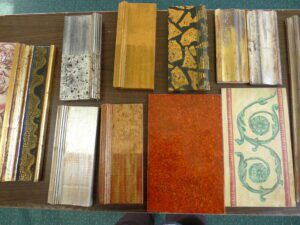 Join us in exploring the practice of the ancient art of gilding ~ the technique of applying thin leaves of pounded metal to a prepared surface. Umbria and Tuscany will afford us inspirational examples of the finest in gilding arts, which you will view in person on our museum excursions. You will become well versed in identifying these time-honored techniques while also taking advantage back in our studio, of newer materials, and exciting contemporary applications. This workshop is of interest to painters, book artists, woodworkers, surface designers and those interested in mixed-media applications.
Join us in exploring the practice of the ancient art of gilding ~ the technique of applying thin leaves of pounded metal to a prepared surface. Umbria and Tuscany will afford us inspirational examples of the finest in gilding arts, which you will view in person on our museum excursions. You will become well versed in identifying these time-honored techniques while also taking advantage back in our studio, of newer materials, and exciting contemporary applications. This workshop is of interest to painters, book artists, woodworkers, surface designers and those interested in mixed-media applications.
In the first week, students will create a series of sample boards using a variety of techniques on prepared hardboard, paper and wood. Beginning with the importance of ground preparation, students will discover the fundamentals of water-based mordant gilding with Dutch metal, aluminum, copper leaf as well as 23-karat gold leaf.
Traditional Renaissance surface embellishment processes shall be explored ~ sgrafitto “to scratch through”; granito, a technique for creating background texture and patterns; and pastiglia, a form of low relief which creates a raised surface. We will also cover antiquing and distressing – as well as non- traditional surface applications with gouache paint.
A selection of templates featuring ornamental designs as well as ornamental initials will be available for easy transfer to a variety of ground surfaces ~ no drawing skills needed. However, please feel free to bring your design ideas and other inspirational materials for your individual projects during the second week.
The 2-week workshop will be rounded out with trips to Florence and Deruta.
Participants will be housed in the remarkably well-preserved Umbrian hill town of Monte Castello di Vibio. Your workshop package is all-inclusive, providing welcome and departure services and airport transfer from the Rome Fiumicino, Leonardo Da Vinci Airport (FCO). Aboard our comfortable private bus, single occupancy accommodations with shared bath (a wide range of upgrades with private bath are available), 3 meals per day Monday-Thursday, Prosecco brunch and dinner on Saturday and Sunday (no meals are served on Friday, our excursion day. Your workshop includes one excursion per week and many additional options are available on weekends for an additional fee. Of course, 24/7 access to facilities and 24/7 bi-lingual support are provided.
 Acclaimed Painter and Illustrator Cornel Rubino will lead a 2-week workshop at the International Center for the Arts, on the creation of monumental works of visual art.
Acclaimed Painter and Illustrator Cornel Rubino will lead a 2-week workshop at the International Center for the Arts, on the creation of monumental works of visual art.
Develop an ease in working large - explore how scale alters the way we view our world by drawing directly from life to re-translate nature and rethink the human condition.
Art, like spoken language, has a vocabulary all its own. With drawing, you will be exposed to elements of thisvocabulary, which serves as the raw material for all visual information. This workshop explores and utilizes drawing to explore the figure in narrative and poetic (non- narrative) ways.
You will be drawing vertically in studio on heavy weight Rives or Fabriano paper no smaller than 7 ft. from live models, fleshy and ideal, as well as lyrical and moody objects of your choice from nature. A variety of wet and dry media will be explored and developed as well as the skills needed to tackle large scale drawings translated from your smaller sketches and ideas. You will experience drawing the figure as it empowers and informs your work, carefully raiding the mines of visual desire.
Drawing on a large scale offers a freedom that is exciting and liberating. You will have the opportunity to create and make the kind of marks that only working on a large-scale surface allows you. We will be working on heavy-duty paper so you will have the opportunity to draw wet with inks or water based paints or dry with pencils, pastels or charcoals. Or mix materials together. The sky’s the limit.
You will work on at least 3-4 large drawings depending on time constraints. We will have individual and group discussions about the work in progress and develop our skills in constructive criticism, working at understanding the significance and psychological importance of line, value, form and composition in the process of image making.
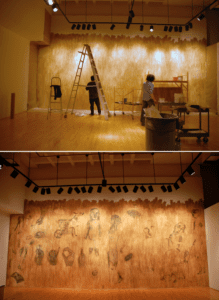 Along with trips to Florence and Perugia, we will draw on the history of Monte Castello as a gathering place for artists in a variety of mediums and scholars in disciplines across the humanities. Painters, sculptors, musicians and chefs will also be in residence at ICA, providing optional lectures or demonstrations and joining retreat participants for communal meals on the terrace. There is a strong opportunity for cross-pollination of ideas and unexpected inspiration for those who seek it.
Along with trips to Florence and Perugia, we will draw on the history of Monte Castello as a gathering place for artists in a variety of mediums and scholars in disciplines across the humanities. Painters, sculptors, musicians and chefs will also be in residence at ICA, providing optional lectures or demonstrations and joining retreat participants for communal meals on the terrace. There is a strong opportunity for cross-pollination of ideas and unexpected inspiration for those who seek it.
Participants will be housed in the remarkably well-preserved Umbrian hill town of Monte Castello di Vibio. Your workshop package is all-inclusive, providing welcome and departure services and airport transfer from the Rome Fiumicino, Leonardo Da Vinci Airport (FCO). Aboard our comfortable private bus, single occupancy accommodations with shared bath (a wide range of upgrades with private bath are available), 3 meals per day Monday-Thursday, Prosecco brunch and dinner on Saturday and Sunday (no meals are served on Friday, our excursion day. Your workshop includes one excursion per week and many additional options are available on weekends for an additional fee. Of course, 24/7 access to facilities and 24/7 bi-lingual support are provided.
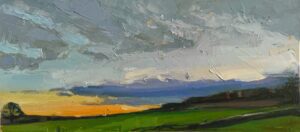 Situated in one of the most beautiful regions of Italy, the idyllic medieval hill town of Monte Castello di Vibio, provides both amazingly picturesque vistas as well as unique challenges for the painter. Majestic mountains stairstep their way into the distance, as their deep green forested hillsides fade to blue gray. The famed, Tiber River, winds like a giant serpent through the valley on its path to Rome, and farm fields and meadows become ribbons on hillsides.
Situated in one of the most beautiful regions of Italy, the idyllic medieval hill town of Monte Castello di Vibio, provides both amazingly picturesque vistas as well as unique challenges for the painter. Majestic mountains stairstep their way into the distance, as their deep green forested hillsides fade to blue gray. The famed, Tiber River, winds like a giant serpent through the valley on its path to Rome, and farm fields and meadows become ribbons on hillsides.
In describing this environment, one cannot help but wax poetic about the opportunities that it provides for the landscape painter. Itis a place both steeped in history, yet constantly changing. Gates open to panoramas that locals refer to as Porta Montanna (“Door to the Mountains”) and the south-facing, Porta Maggio (“Door of May”). To the southwest, where mountain ridges collide above the village of Doglio, the Bocca della Stregna (the Witches Mouth) sometimes reveals the source of its name as the moaning wind circles through its crevices. Castles in the distance appear and disappear in the morning fog as swallows dart in and out of a vista called simply, il Mare (the sea). Far off in the distance to the east lie the mysterious Sibillini Mountains, home of the famed Sybill and the mountain towns of Norcia and the breathtaking valley of Castelluccio, where wildflowers carpet the ground and wolves still howl at night. It is a timeless landscape where past and present meet in the eyes of those lucky enough to experience it. This workshop and your immersion in the surroundings will provide unforgettable experiences. This non-touristed location will allow you to enjoy this small town and its authentic ambiance.
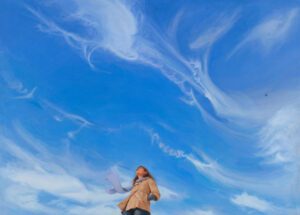 Participants will be housed in the remarkably well-preserved Umbrian hill town of Monte Castello di Vibio. Your workshop package is all-inclusive, providing welcome and departure services and airport transfer from the Rome Fiumicino, Leonardo Da Vinci Airport (FCO). Aboard our comfortable private bus, single occupancy accommodations with shared bath (a wide range of upgrades with private bath are available), 3 meals per day Monday-Thursday, Prosecco brunch and dinner on Saturday and Sunday (no meals are served on Friday, our excursion day. Your workshop includes one excursion per week and many additional options are available on weekends for an additional fee. Of course, 24/7 access to facilities and 24/7 bi-lingual support are provided.
Participants will be housed in the remarkably well-preserved Umbrian hill town of Monte Castello di Vibio. Your workshop package is all-inclusive, providing welcome and departure services and airport transfer from the Rome Fiumicino, Leonardo Da Vinci Airport (FCO). Aboard our comfortable private bus, single occupancy accommodations with shared bath (a wide range of upgrades with private bath are available), 3 meals per day Monday-Thursday, Prosecco brunch and dinner on Saturday and Sunday (no meals are served on Friday, our excursion day. Your workshop includes one excursion per week and many additional options are available on weekends for an additional fee. Of course, 24/7 access to facilities and 24/7 bi-lingual support are provided.
The immersive two-week workshop will cover the essential aspects of outdoor landscape painting: choosing a motif, working quickly and directly, controlling value and color to create compelling harmonies, and thinking intentionally about form.
We will meet together four days a week, with weekends allowing time for independent painting time and Friday’s reserved for excursions. The first week will include ample instruction and support from the instructor. The second week students will be guided as they approach the landscape with more confidence and clarity. Painting sessions will be scheduled generally: 9am-1pm and 4pm-7pm Monday-Thursday. Included in the workshop are two local excursions: Assisi to see the unforgettable Giotto frescos and to Perugia to the national museum.
 Fueled by a new interest in the individual, the birth of the Renaissance in Florence in the 15th century brought a rebirth of the long dormant art of Portraiture. What better place to study the practice and history of Portraiture than in Monte Castello di Vibio, just a stone’s throw from that extraordinary city?
Fueled by a new interest in the individual, the birth of the Renaissance in Florence in the 15th century brought a rebirth of the long dormant art of Portraiture. What better place to study the practice and history of Portraiture than in Monte Castello di Vibio, just a stone’s throw from that extraordinary city?
In this two-week workshop, students will be immersed in the Art of the Portrait. Working daily from the live model, they will study the structure of the head, beginning with seeing the skull as it presents itself in each individual. Through demonstrations, slide presentations, and one on one critiques as they work, they will learn to identify the shapes and planes specific to an individual model and to understand the principles of traditional design inherent in each portrait.
This Portraiture workshop is perfect for anyone wanting to learn to draw or paint portraits or to improve in their already existing portrait practice. Since so much teaching happens one-on-one, both beginners and more seasoned artists will benefit greatly from the intensive experience of studying and drawing/painting daily for two weeks. The small class size (limit of 10) will ensure ample instruction for each student.
Students are welcome to draw or paint, depending upon their level of experience.
Class time will be supplemented with two field trips to world class museums in Florence and Rome. These excursions will serve to deepen students’ understanding of the skills and concepts they’re learning. In addition, they’ll come to appreciate the history of Portraiture itself and its place in the overall history of art.
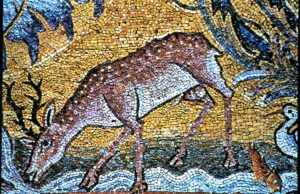 Learn to create mosaics—the most enduring form of pictorial art with a master of the medium – in a country renowned for some of the most spectacular examples of mosaic art.
Learn to create mosaics—the most enduring form of pictorial art with a master of the medium – in a country renowned for some of the most spectacular examples of mosaic art.
In this hands-on course, Rick Shelley will demonstrate the methods of mosaic production. Students will shape stone, glass, and ceramic into tesserae for their projects. Experiment with glues and cements to adhere tesserae onto the wooden panels provided. One class will concentrate on working with the beautiful and traditional practice of gold leafing glass. Using this simple, but remarkable technique, color of extraordinary depth is possible. A truly remarkable medium! Students will be encouraged to design and execute several small mosaics. The focus will be on form, outlines, shadows, and highlights. Simple images, letters, or symbols are ideal subjects.
The International Center for the Arts provides the perfect atmosphere to experience the mosaic arts. Surrounded by the Italian countryside, the studio at Monte Castello di Vibio is an oasis in which to work and learn. The course combines intensive instruction with excursions to nearby mosaic treasures. Roman mosaics, Byzantine mosaics, and contemporary mosaics will be studied for inspiration – and experienced in person! Our goal is to enjoy and create beautiful mosaics while being immersed in this wondrous experience.
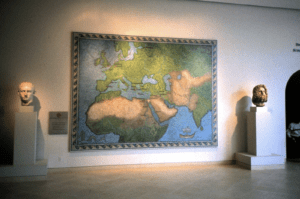 All the while, participants will be housed in the remarkably well-preserved Umbrian hill town of Monte Castello di Vibio. Your workshop package is all-inclusive, providing welcome and departure services and airport transfer from the Rome Fiumicino, Leonardo Da Vinci Airport (FCO). Aboard our comfortable private bus, single occupancy accommodations with shared bath (a wide range of upgrades with private bath are available), 3 meals per day Monday-Thursday, Prosecco brunch and dinner on Saturday and Sunday (no meals are served on Friday, our excursion day. Your workshop includes one excursion per week and many additional options are available on weekends for an additional fee. Of course, 24/7 access to facilities and 24/7 bi-lingual support are provided. All supplies are included. The course will include visits to Florence and Rome and while in Rome will visit the Vatican Museums.Finally, as an additional excursion, we will visit Orvieto’s splendid medieval cathedral to see the exterior mosaics and interior frescos.
All the while, participants will be housed in the remarkably well-preserved Umbrian hill town of Monte Castello di Vibio. Your workshop package is all-inclusive, providing welcome and departure services and airport transfer from the Rome Fiumicino, Leonardo Da Vinci Airport (FCO). Aboard our comfortable private bus, single occupancy accommodations with shared bath (a wide range of upgrades with private bath are available), 3 meals per day Monday-Thursday, Prosecco brunch and dinner on Saturday and Sunday (no meals are served on Friday, our excursion day. Your workshop includes one excursion per week and many additional options are available on weekends for an additional fee. Of course, 24/7 access to facilities and 24/7 bi-lingual support are provided. All supplies are included. The course will include visits to Florence and Rome and while in Rome will visit the Vatican Museums.Finally, as an additional excursion, we will visit Orvieto’s splendid medieval cathedral to see the exterior mosaics and interior frescos.
Our Mosaics in Italy with Rick Shelley workshop is a rare opportunity to study with a master of the medium in a country renowned for some of its greatest examples. All the while, participants will enjoy a rare immersion in traditional culture, enjoy incredible views made possible by our mountaintop location, delight in gourmet and traditional food prepared fresh by expert chefs from fresh, locally sourced ingredients all accompanied by excellent local wine (or optional selections from our wonderful Wine List, for an additional fee). It is a rare experience, available to only 10 participants.